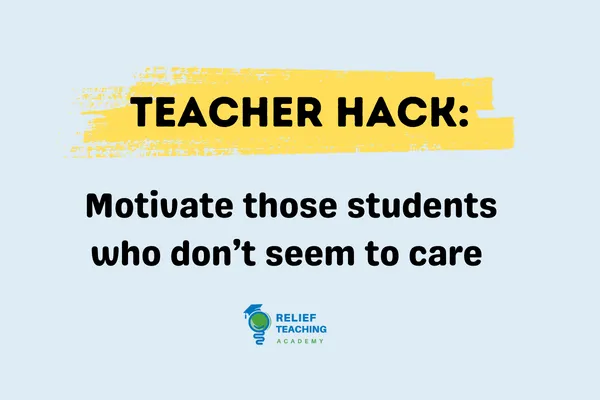Latest Academy Blogs
Select article category or search for specific article:

5 Powerful Ways for Motivating Students Who Don’t Care
Motivating students is probably one of the most difficult tasks when relief teaching. There are a lot of unmotivated kids out there.
We all know that motivating students will help with behaviour management. Motivated students seldom misbehave. Unfortunately, unmotivated kids often do.
If your teaching strategies are not motivating students, you will probably be having one tough relief teaching day.
These teaching strategies can help motivate students (and maybe even relief teachers too!):
#1 Explain –
Not surprisingly, students tend to do poorly on tasks when they do not understand what to do or why they should do it. Students who are uncertain about what to do will seldom perform well and with almost no motivation at all.
If you are a relief teacher, you may find it helpful to spend time explaining
why we teach what we do and
why the activity is important.
#2 Reward –
Good kids have developed their sense of intrinsic reward, but many do not yet have the intrinsic motivation to learn. Rather than criticizing unwanted behaviour or answers, try make a point of rewarding correct behaviour and answers.
Use teaching strategies where students CAN be rewarded.
Rewards can be whatever lights your fire or as simple as the following:
A pat on the back or some form of acknowledgement in front of peers.
Most classrooms have stickers
Some classrooms have prizes
Or for a really powerful reward – a phone call to mum/dad in front of the class! Whip out the phone and call in front of the kid and the class.
A 30-second conversation that goes something like this. “Hello, Mr Brown. This is Bob Brandis. I’m sorry to interrupt, but I just rang to say Bill is having a fabulous day and trying his hardest at his school work. Thanks for your support at home. Have a nice day!” Honestly, every mouth drops in the class and Mr Brown is probably receiving CPR at work. Or even leave the same message on voicemail. You can imagine the kids rushing to get home and waiting for Mum to arrive.
Whichever teaching strategies you use, the important point is that extrinsic motivators can, over a brief period, produce intrinsic motivation.
#3 Care –
Be passionate about making certain students know that you care about their results.
Students respond to teachers who appear as caring. Personalising the student/teacher connection allows students to see teachers as approachable.
Show that you care about your students by asking about their learning and what they plan to do in the future.
#4 Involve and Participate –
One of the major keys to motivation is the active involvement of students in their learning.
Use teaching strategies that get students involved in activities. It’s not difficult to have students participate in their learning. Such involvement also creates greater ownership. 12 Easy Strategies to Engage Students
#5 Teach Inductively –
It has been said that presenting conclusions first and then providing examples robs students of the joy of discovery.
Why not present some examples first and ask students to make sense of them? Students could try to generalise and draw the conclusions themselves.
By beginning with the examples and arriving at conclusions later, you can maintain interest and increase motivation. It will also allow students to learn the skills of analysis and synthesis.
We all know that motivating students will help with behaviour management. Motivated students seldom misbehave. Unfortunately, unmotivated kids often do.
If your teaching strategies are not motivating students, you will probably be having one tough relief teaching day.
These teaching strategies can help motivate students (and maybe even relief teachers too!):
#1 Explain –
Not surprisingly, students tend to do poorly on tasks when they do not understand what to do or why they should do it. Students who are uncertain about what to do will seldom perform well and with almost no motivation at all.
If you are a relief teacher, you may find it helpful to spend time explaining
why we teach what we do and
why the activity is important.
#2 Reward –
Good kids have developed their sense of intrinsic reward, but many do not yet have the intrinsic motivation to learn. Rather than criticizing unwanted behaviour or answers, try make a point of rewarding correct behaviour and answers.
Use teaching strategies where students CAN be rewarded.
Rewards can be whatever lights your fire or as simple as the following:
A pat on the back or some form of acknowledgement in front of peers.
Most classrooms have stickers
Some classrooms have prizes
Or for a really powerful reward – a phone call to mum/dad in front of the class! Whip out the phone and call in front of the kid and the class.
A 30-second conversation that goes something like this. “Hello, Mr Brown. This is Bob Brandis. I’m sorry to interrupt, but I just rang to say Bill is having a fabulous day and trying his hardest at his school work. Thanks for your support at home. Have a nice day!” Honestly, every mouth drops in the class and Mr Brown is probably receiving CPR at work. Or even leave the same message on voicemail. You can imagine the kids rushing to get home and waiting for Mum to arrive.
Whichever teaching strategies you use, the important point is that extrinsic motivators can, over a brief period, produce intrinsic motivation.
#3 Care –
Be passionate about making certain students know that you care about their results.
Students respond to teachers who appear as caring. Personalising the student/teacher connection allows students to see teachers as approachable.
Show that you care about your students by asking about their learning and what they plan to do in the future.
#4 Involve and Participate –
One of the major keys to motivation is the active involvement of students in their learning.
Use teaching strategies that get students involved in activities. It’s not difficult to have students participate in their learning. Such involvement also creates greater ownership. 12 Easy Strategies to Engage Students
#5 Teach Inductively –
It has been said that presenting conclusions first and then providing examples robs students of the joy of discovery.
Why not present some examples first and ask students to make sense of them? Students could try to generalise and draw the conclusions themselves.
By beginning with the examples and arriving at conclusions later, you can maintain interest and increase motivation. It will also allow students to learn the skills of analysis and synthesis.

CLICK HERE to find out more about joining the Relief Teaching Academy
Subscribe to get up to date tips, strategies, resources and guidance on all things relief teaching.
Relief Teaching Academy is a service of EPC Capital Pty Ltd.
© Copyright 2023. EPC Capital Pty Ltd. All rights reserved.
Send us a message
